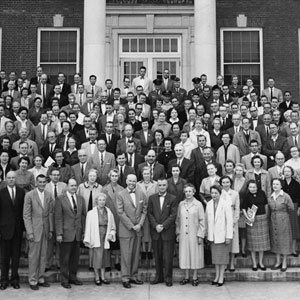
Just days after shocking the campus by announcing his resignation, John Decatur Messick (1897-1993), president of East Carolina College, 1947-1959, posed for a final picture taken on the front steps of Flanagan Building along with a sizable group faculty and staff. The photo’s backside bears the signature of Fred Robertson, photographer for the East Carolinian, and an inscription, “With Kind Regards.” Another hand attributes the photo to Robertson and Jimmy Kirkland, photographer for the Buccaneer, adding that it was taken on “Wednesday, October 28, 1959, five days after President Messick’s resignation.” Given the suddenness of Messick’s departure, this gathering served as the only campus celebration of his twelve years as president of the school.
Messick, 62 at the time, was not retiring. Instead, he continued to work, first briefly in Washington, D.C. as a research assistant for the House of Representatives Committee on Education and Labor, then as a dean of instruction at Lyndon State College in Vermont, and finally as provost and dean of instruction at Oral Roberts University. When he finally retired in 1968, he did so at age 70, due to the mandatory requirement which he, as author of the Oral Roberts Faculty Handbook, had drafted. None of Messick’s subsequent positions afforded him the power and prestige of a campus presidency, but then again, his years at ECC were not his most beloved. Although a native North Carolinian, when Messick departed ECC, he explained that he was tired of being tired, but of his years at Oral Roberts, Messick himself said they had been “the happiest and most beneficial years of my life.”
By any measure, Messick’s contributions to East Carolina were monumental. According to the High Point Enterprise, Messick “was well along the way to building his own university of a stature and size equaling the state’s three-pronged University.” The Greensboro Daily News praised Messick for having “lifted the sagging spirit at East Carolina.” The News and Observer added that Messick had “done a great job in building the college and its service to the area.” The Winston-Salem Journal declared that the growth of ECC during Messick’s years had been “little short of sensational.”
An editorial in the East Carolinian declared Messick an “excellent president.” A student tribute described Messick’s tenure as a “glorious era,” noting how his “brilliant record as an educator and public servant has been heralded everywhere.” East Carolina’s transformation during the Messick era was phenomenal. The school evolved from a teachers college to a four-year liberal arts college. Enrollment nearly tripled, from 1,404 in 1947 to 4,045 in 1959. The number of faculty also tripled. The campus grew by 50% with eleven new buildings added, plus a new football stadium. Moreover, 80 acres was purchased for future expansion. Major curricular innovations occurred matching the school’s new breadth of mission.
Yet there were also imperatives neglected. Despite the Brown v. Board of Education Supreme Court of 1954 decision declaring “separate but equal” facilities in public schools unconstitutional, Messick repeatedly appealed to the school’s Jim Crow charter as a means of sidestepping the inevitable. By 1956, the University of North Carolina at Chapel Hill, North Carolina State College (later, NCSU), and Woman’s College in Greensboro (later, UNC-G), had all desegregated under court order. With Messick’s leadership, East Carolina had grown into their ranks, making its desegregation imminent. Yet rather than proactively helping East Carolina navigate that important transformation, Messick left the task to his successor, Dr. Leo W. Jenkins.
Sources
- Bratton, Mary Jo. East Carolina University: The Formative Years, 1907-1982. Greenville, N.C.: East Carolina University Alumni Association, 1986.
- “East Carolina Loses Excellent President.” East Carolinian. October 29, 1959. Vol. 35, no. 7. P. 2.
- Ferrell, Henry C., Jr. No Time For Ivy: East Carolina University, 1907-2007. Greenville, N.C.: East Carolina University, 2006.
- Harrell, David Edwin, Jr. Oral Roberts: An American Life. Bloomington: Indiana University Press, 1985.
- Jackson, Tom. “Messick’s Resignation Causes Shock, Sadness.” East Carolinian. October 29, 1959. Vol. 35, no. 7. P. 2.
- “Messick Resigns; News Shakes Campus.” East Carolinian. October 29, 1959. Vol. 35, no. 7. P. 1.
- “Student Gives Final Tribute.” East Carolinian. October 29, 1959. Vol. 35, no. 7. P. 2.
Citation Information
Title: John Messick's Resignation
Author: John A. Tucker, Ph
Date of Publication: 7/19/2019